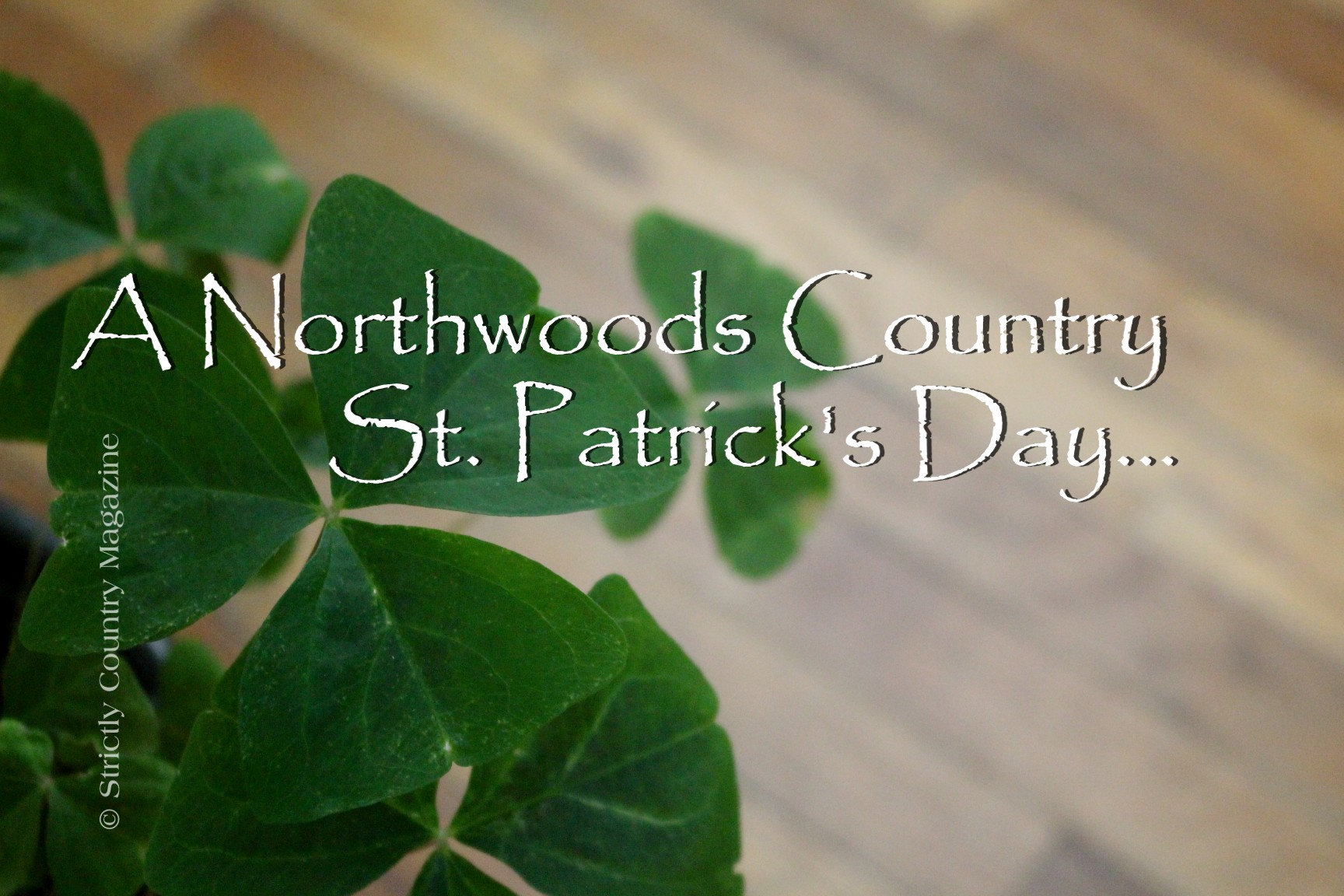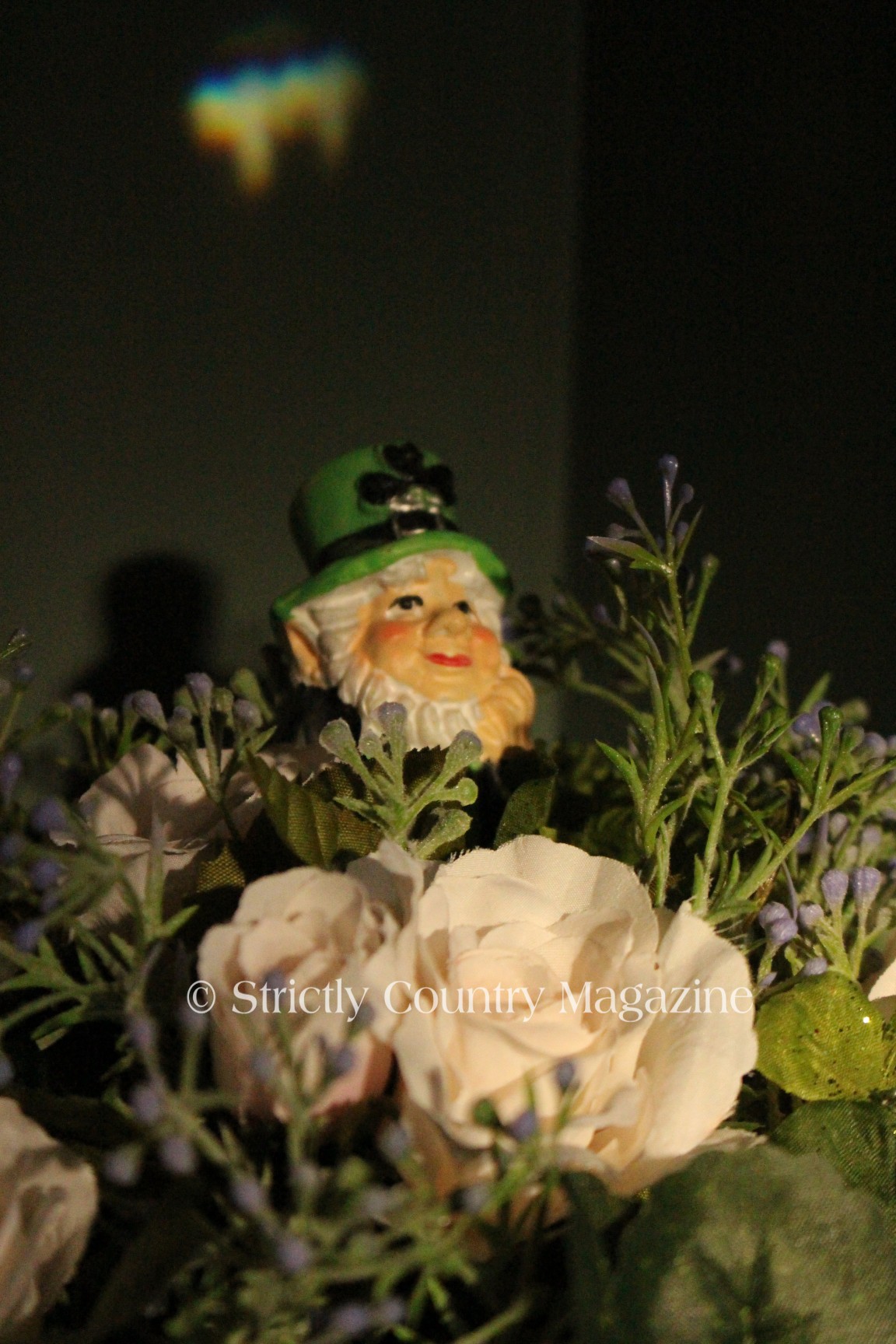
Please shop now!
WE ARE IN THE FINAL DAYS OF CLOSING THIS SITE FOR GOOD!!!
Please make your selection and purchases NOW!
This site is slated permanently shut down any day!

Tellin’ an ol’ Irish Tale...
A Northwoods Country St. Patrick’s Day
Deep in the Northwoods of Wisconsin and Minnesota you will find an old Irish pub or two. Sure this region was mainly inhabited by Germans, but there are few Norwegians, Swedes and Dutch as well. But today we find ourselves amongst the Irish for it is March and St. Paddy’s Day is near.
March in the Northwoods, is a transitional month. One day the sun will shine to warm the soul and then the next day the snow will fall. Temperatures can range from the mid to low fifties all the way down into the teens. One can experience all four seasons within a week, up here in the Northwoods…
If you’re lucky enough to be Irish…
Then you’re lucky enough!
Aye. Well, come on in and hang your coat right over there on that peg. Belly up to the bar and grab yourself a pint and one for your brother too. The peat is burning nice and hot in the teallach over yonder if you’re cold. You know, we Irish are great storytellers…especially times of old.
If ya can’t dazzle them with brilliance,
Baffle them with blarney!
It is no blarney that Saint Patrick’s day, also known as the Feast of Saint Patrick, is typically a religious celebration held in honor of the patron Saint of Ireland – Saint Patrick. This religious celebration takes place annually on March 17th. Mostly observed by the Catholic Church, this celebration is honored across the globe in many countries.
According to Wikipedia, the “…Day was made an official Christian feast day in the early 17th Century.” “The day commemorates Saint Patrick and the arrival of Christianity In Ireland, and celebrates the heritage and culture of the Irish in General.”
What the site does not explain is how Christianity destroyed Ireland. Prior to Patrick’s arrival, Ireland was inhabited by two groups – the Pagans and the Celts. If you set aside your man written Bible and open yourself up to the truth you shall see that both groups were for the most part peaceful societies. If you look beyond the customary lies, Pagans and Celts live their lives honoring the seasons and the earth’s transitions.
After Patrick’s accomplishment of ‘driving out the snakes,’ Ireland was open to other civilizations that created much havoc. Perhaps the most notable is of the invasion of the Vikings. The British Crown was another who violated the Irish people after the invasion of the Anglo-Normans. Another notable invasion came in 1649 with Oliver Cromwell; which removed the Irish from ownership of land with the Cromwellian Act of Settlement. Sixteen years later, the Act of Explanation passed which ordered the Cromwellian settlers to give back one-third of the land to only Catholics. Many other acts and acts of war continued. By the 19th Century, poverty was common and the state of affairs was grim in Ireland; especially in the hands of non-Catholics. Later, things would turn violent as the fight for land continued.
Perhaps the significant lie surrounding the day comes with the fact that St. Patrick was not the only person who devastated Ireland with his Christian beliefs. Prior to his arrival there were many from the Roman Catholic Church who tried to convert the First Peoples of Ireland.
Perhaps the most significant is of a woman, Brigid, also known as St. Brigid of Kildare. Once again, the Catholic Church tries to deceive the people into believing Brigid was working for the Church. In reality, Brigid was not. In fact she was working for the better of her people – The Celts. However, the Church in its deceitful way spins an Irish tale that puts Brigid sidling up with Patrick in converting her people to Christianity.
There are only two kids of people in the world,
The Irish and those who wish they were.
That being said, perhaps it is time we speak about music. Irish music is one of the foremost recognizable music genres in the world. The best way to describe the style it’s a diverse collection of folk music with many regional variations. Most of the music is set for dancing, nonetheless, the best songs are performed in the substantial ballad traditions. One can simply identify the characteristics by the use of instruments. Traditional Irish instruments wielded in the music include fiddle, bodhran, wooden flute, tin whistle, Uillean pipes, and the Irish harp. One can nearly claim that Country Music as well as Bluegrass emanates from Irish or Celtic music. If you truly dissect the genre, you will find a correlation of Irish settlers within the areas where real Country Music was forged.
Through the years many country music entertainers have recorded songs that can be claimed as Irish or Celtic music.
In 2016, Sylvia released her album It’s All In The Family. Within the album she included the song “Immigrant Shoes.” Performed in the Celtic manner the song captures the impression one would have had when they arrived at Ellis Island as an immigrant.
“I love that song! That song was so fun to write. I’m such a big advocate of looking into ancestry. I’m a member of Ancestry.com, had been for many years. I have my family tree up there and all that kind of thing. Occasionally I’ll go down that rabbit hole, to come up hours later!” laughs Sylvia. “So that was the inspiration for that song. I sat down with my friend Thom Schuyler to write a lyric to this music that John Mock wrote. He had written this incredible piece of music, “Immigrant Shoes.” At the time, you know it wasn’t named. We didn’t even know what it was going to be about. What I like to do is, when John writes a piece of music, I like to just live with the music for a while and just let it bring images to my mind. That’s what happens. So, I was sitting with Thom Schuyler after he and I had both done the same thing, lived with it a little while. I said ‘I’m getting pictures of family, like some of my ancestors I’ve never met.’ We began talking about that and I think Thom came up with the image of immigrant shoes and it just took off from there. We just began imagining what it was like for our ancestors coming over, hundreds of years ago. So that was the inspiration.”
In 1995, Garth Brooks released his critically acclaimed album Fresh Horses. The album included a beautiful folk ballad called “Ireland.” Brooks wrote the song with Stephanie Davis and Jenny Yates. The song begins with a beautiful explanation of the Emerald Isle then it progresses to a military setting with the blazing of bagpipes and bodhrans. Although the song does not specify a particular battle it does speak of men in battle and upon their deaths they long for home. Home, in this case is the emerald isle of Ireland.
Chances are you may not know composer Chauncey Olcott. Nonetheless, you have heard two of his more notable songs “My Wild Irish Rose” and “When Irish Eyes Are Smiling.” Born in 1858, Mr. Olcott was an American stage actor, songwriter and singer of Irish descent. His mother was a native of Killeagh, County Cork, Ireland. He was known to “capture the mood of his Irish-American audience by combining melodic and rhythmic phrases from traditional Irish music with melancholy sentiment.” [Wikipedia] It is said Chauncey wrote the two songs after visiting his mother’s home land. In 1958, Hank Locklin went on to record his version of Chancey’s “My Wild Irish Rose.”
One of the more notable Irish songs is “When Irish Eyes Are Smiling;” the lyrics were written by Olcott and George Graff, Jr. The music was composed by Ernest Ball. Many notable entertainers have recorded their version of this classic Irish song including Hank Locklin, Bing Crosby, and Connie Francis.
“Danny Boy” is perhaps the most common of the Irish songs we know today. The ballad was written in 1913 by English songwriter Frederic Weatherly and set to the traditional Irish melody of “Londonderry Air.” As the story goes, Weatherly wrote the words to “Danny Boy” to another tune in 1910. His Irish-born sister-in-law Margaret Enright Weatherly of the United States sent him a copy of “Londonderry Air” in 1913. Weatherly went on to modify the lyrics to fit the rhyme and the meter of the tune to produce the song we know today. Versions of the song have been recorded by many entertainers including Bing Crosby, Andy Williams, Jim Reeves, Johnny Cash, Elvis Presley, Glenn Miller, Conway Twitty, Connie Francis, Ray Price, Roy Orbison, Glen Campbell, Willie Nelson, Jimmy Fortune, Judy Garland; to name a few. It is customary to have this song played at one’s funeral, especially if you are Irish.
In 2014, we introduced you to a new band named Trinity River Band when they released their sophomore album Better In Blue. The album featured twelve cuts including a Celtic immersed song called “William And Mary.” Performed as a ballad, the song stays true to Irish lyrics as it tells the love story of the couple.
In 2011, Spirit Award winner and guitarist Pete Huttlinger recorded and released his album Black Swan. During a conversation prior to his death, Pete talked about the album and how he paid a visit to Ireland to learn how to play Celtic music on his guitar. The album is filled with eleven beautifully orchestrated instrumental songs performed in the traditional warm Celtic timbre.
May your pockets be heavy and your heart be light.
May good luck pursue you each morning and night.
- Irish blessing
To speak of St. Patrick’s Day is to speak of shamrocks, leprechauns, and luck. Over the years we have heard many songs where luck was the subject. One you may not know of comes from George Jones. In 1983, Jones released his song “I Always Get Lucky With You.” Written by Merle Haggard, Freddy Powers, Gary Church, and Tex Whitson; was first recorded in 1981 by Merle. Nonetheless, it was Jones’ version the public enjoyed. Performed in the classic two-step ballad, the song was Jones’ last chart topper.
In 2005, we introduced you to new entertainer Eddie Bush when he released self-entitled debut album. From that album we found “Call Me Lucky.” Performed in a face paced catchy tune, the song tells the story of how a man feels lucky when he captures the love of girl.
On May 18, 1992, the greatest song written about luck was released. “I Feel Lucky” was the first single released off of Mary Chapin Carpenter’s album Come On Come On. Written by Carpenter and Don Schlitz, the song became a popular tune among country music fans while earning the No. 4 peak position on Billboard’s Hot Country Songs and earning a year end [1992] position of No. 15. The song tells the tale of a woman who repeatedly receives bad omens for the upcoming day, however, she disregards the signs saying ‘I feel lucky.’ In the end the woman has the best day of her life; winning the lottery and meeting Lyle Lovett and Dwight Yoakam. The moral of the story – “the stars might lie, but the numbers never do…” in other words, stay positive.
May the sound of happy music, and the lilt of Irish laughter,
Fill your heart with gladness that stays for here after.
It doesn’t take a pint or two to know many Country Music entertainers can claim an Irish heritage. Nonetheless, in 2012 we were introduced to Irish folk and country singer Pete Kennedy when he released his The Nashville Sessions Vol. 2” album. The album features six beautifully recorded songs including one we bring to this list called “Do You Take This Girl.” Pete captures his Irish upbringing in this beautiful ballad fit for any wedding ceremony.
The older the fiddle…
The lovelier the tune!
Shortly after announcing his retirement, Don Williams released his last known project called Don Williams In Ireland: The Gentle Giant In Concert. Although the album and DVD contain live recordings of Don performing in Ireland, none of the songs can be considered Irish. The flaw of the project is found in the fact that it lacks the complete performance while only showcasing some of Williams’ more notable songs mixed with what seems to be bits of an interview with the lost legend.
“Certain cultures really have their own feeling about what’s country and what’s good music and on and on. Scotland, Ireland...a lot of influence.” shares Don Williams. “The way you put words together and thoughts together, the melody and all that...rhythms...yeah they’ve had a lot of influence on us.”
May your blessings outnumber the shamrocks that grow,
And may trouble avoid you wherever you go.
I can see you need another pint and I need something to wet my own whistle. Just a cup of coffee is fine... as I may be the only Irishwoman that doesn’t drink. Go figure, being from Irish royalty and all…
The sun has gone down and I need to leave. I will tell you this, A Northwoods Country St. Paddy’s Day has been about tales told and tales shared...nonetheless, I think the best tale is about to be told...
So, let us raise our glass and toast to good friends, great music and Irish songs from afar…
And if you want to hear the best tales, come see me in person. ‘Cause some ole’ Irish country tales will never be shared in print…
Slainte mhaith!
© Strictly Country Magazine March 2021.

Related Articles:
A Northwoods Country New Year…
A Northwoods Country Groundhog Day…
A Northwoods Country St. Patrick’s Day…
A Northwoods Country April Fools Day…
A Northwoods Country Earth Day…
A Northwoods Country Mother’s Day…
A Northwoods Country Memorial Day…
A Northwoods Country Father’s Day…
A Northwoods Country 4th of July…
A Northwoods Country Halloween…
A Northwoods Country Veteran’s Day…
A Northwoods Country Christmas…
Get To Know 'Em: Trinity River Band...
Loss of A Legend: George Jones...
Pete Huttlinger: Return To McGuire's Landing...
The Gentle Giant Rests: Don Williams...
© 1993 - 2024 Strictly Country
All Items contained on this site may not be used without written permission
from Strictly Country Magazine.
All Rights Reserved

![]()



